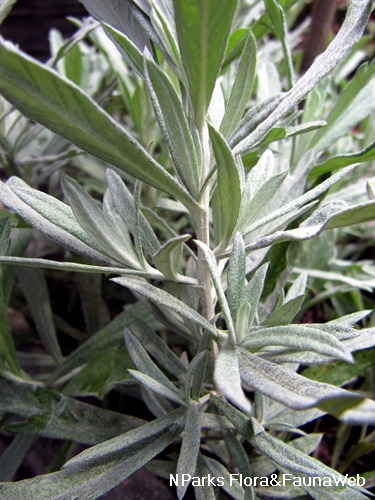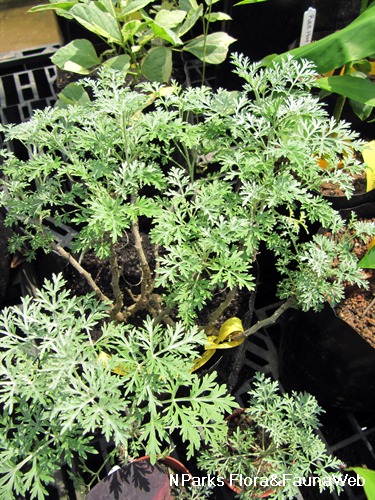
Back
Artemisia ludoviciana 'Silver Queen'
| Family Name: | Asteraceae (Compositae) |
| Common Name: | Wormwood, Armoise de l’ouest |
Name
Classifications and Characteristics
| Plant Division | Angiosperms (Flowering Seed Plants) (Dicotyledon) |
|---|---|
| Plant Growth Form | Shrub |
| Lifespan (in Singapore) | Perennial, Annual |
| Mode of Nutrition | Autotrophic |
| Maximum Height | 30 cm to 90 cm |
Biogeography
| Native Distribution | Widespread in North America. |
|---|---|
| Native Habitat | Terrestrial (Temperate Forest, Grassland / Savannah/ Scrubland, Disturbed Area / Open Ground) |
| Preferred Climate Zone | Temperate |
| Local Conservation Status | Non-native |
Description and Ethnobotany
| Growth Form | It is am aromatic, perennial or annual shrub, up to 90 cm in height, and appears grey-whitish throughout. |
|---|---|
| Foliage | Its alternate, hairy, unstalked leaves are broadly elliptic to linear in shape, with diverse margins ranging from entire to lobed to deeply pinnatifid, 1.5-11 cm long by 0.5-4 cm wide, green, grey-green, white or white and green in colour. |
| Stems | Its stems are hairy and grey-green in colour. |
| Flowers | Its small inflorescences are in the form of composite heads made up of small, individual, bisexual, yellow florets, 1.9-2.8 mm long. |
| Associated Fauna | It is probably insect-pollinated. |
| Cultivation | It can be propagated by seed or stem cutting. |
| Etymology | Latin Artemisia, named after Dioscorides’ name for Artemis (Diana), wife of Mausolus, of Caria, Asia Minor. Latin ludoviciana, latinised form of Louisiana, referring to the distribution and origin of the plant species. |
| Ethnobotanical Uses | Food (Herb or Spice) Medicinal: The leaves are used as an astringent, to induce sweating, reduce pain and cure diarrhoea. The leaves are made into a weak tea to treat stomach ache and menstrual disorders. The leaves are also applied externally to soothe itching, rashes, swellings, boils, sores, treat eczema and also applied as an underarm deodorant. The leaves poultice is used to treat spider bites, blisters and burst boils. The scent released from the crushed leaves is used to treat headaches, the sinuses and nosebleeds. Others: The leaves can act as a foot deodorant by placing them in shoes or other footwear. The soft leaves reportedly used as toilet paper. The plant can also be burnt to release the aroma that repels mosquitoes. |
Landscaping Features
| Desirable Plant Features | Ornamental Foliage, Fragrant (Foliage) |
|---|---|
| Landscape Uses | Small Gardens, Flowerbed / Border |
| Thematic Landscaping | Silver Garden, Fragrant / Aromatherapy Garden |
Fauna, Pollination and Dispersal
| Pollination Method(s) | Biotic (Fauna) |
|---|---|
| Seed or Spore Dispersal | Abiotic |
Plant Care and Propagation
| Light Preference | Full Sun, Semi-Shade |
|---|---|
| Water Preference | Moderate Water |
| Rootzone Tolerance | Moist Soils, Well-Drained Soils, Fertile Loamy Soils |
Foliar
| Foliage Retention | Evergreen |
|---|---|
| Mature Foliage Colour(s) | Silver / Grey, White |
| Mature Foliage Texture(s) | Powdery / Waxy Bloom |
| Foliar Type | Simple / Unifoliate |
| Foliar Arrangement Along Stem | Alternate |
| Foliar Attachment to Stem | Sessile |
| Foliar Shape(s) | Non-Palm Foliage (Lanceolate, Elliptical, Linear) |
| Foliar Venation | Pinnate / Net |
| Foliar Margin | Entire, Pinnately Lobed / Pinnatifid |
Floral (Angiosperm)
| Flower & Plant Sexuality | Bisexual Flowers |
| Flower Colour(s) | Yellow / Golden |
|---|---|
| Flower Grouping | Cluster / Inflorescence |
| Flower Location | Axillary |
Image Repository
Others
| Master ID | 31251 |
|---|---|
| Species ID | 5646 |
| Flora Disclaimer | The information in this website has been compiled from reliable sources, such as reference works on medicinal plants. It is not a substitute for medical advice or treatment and NParks does not purport to provide any medical advice. Readers should always consult his/her physician before using or consuming a plant for medicinal purposes. |







